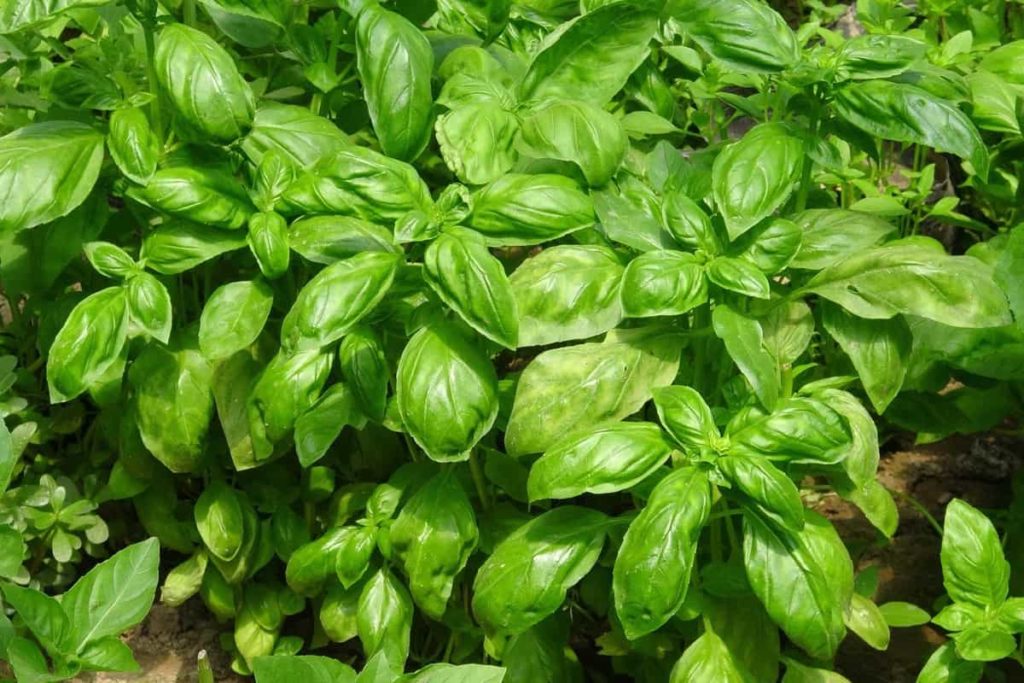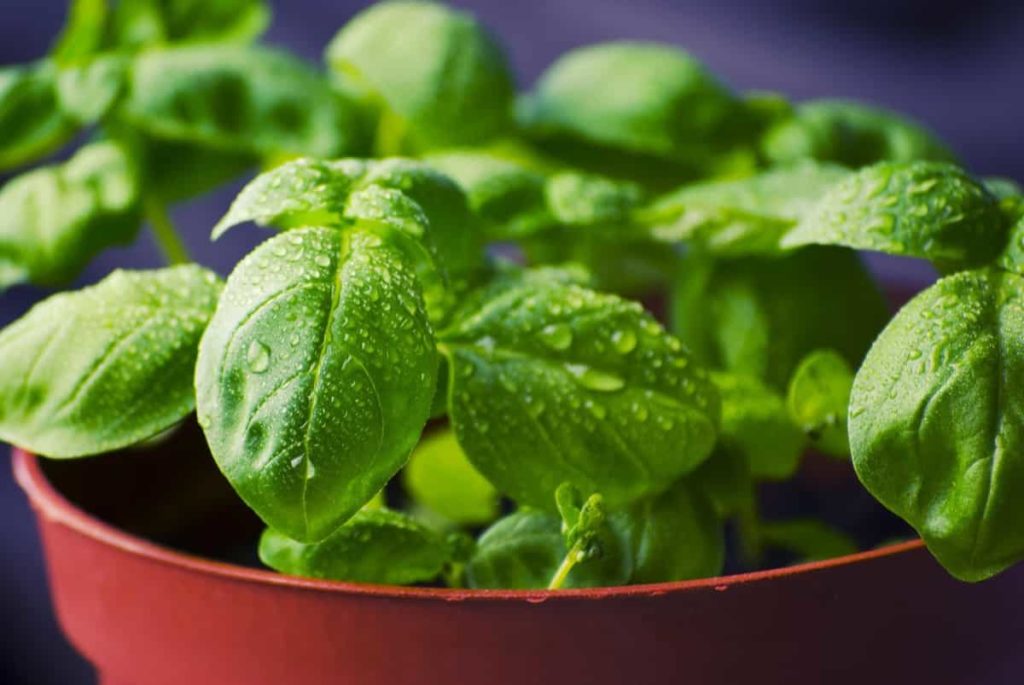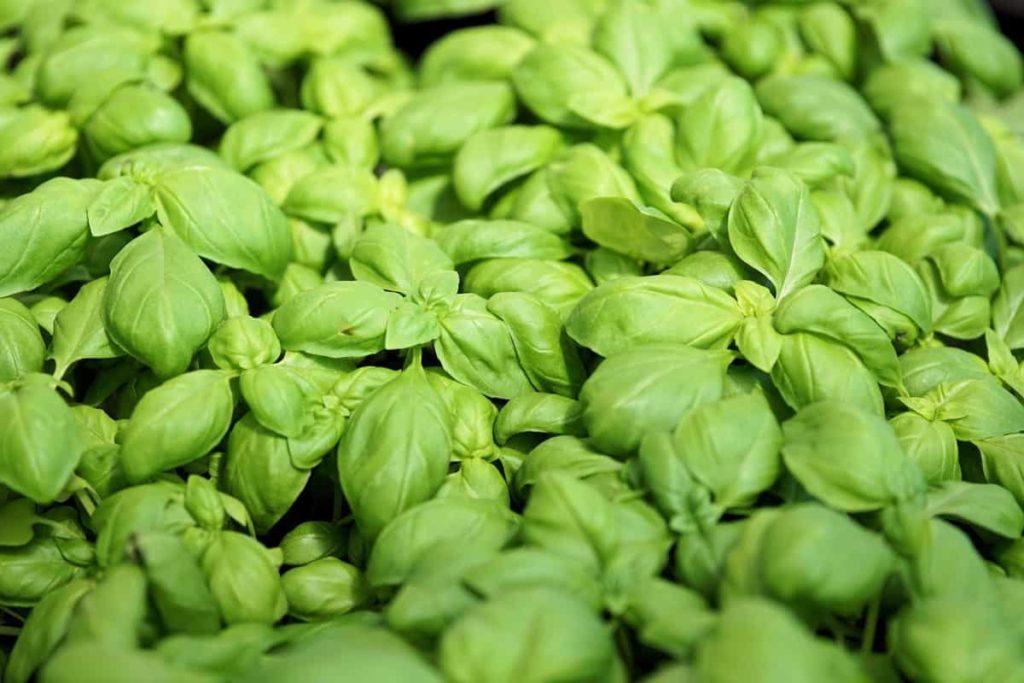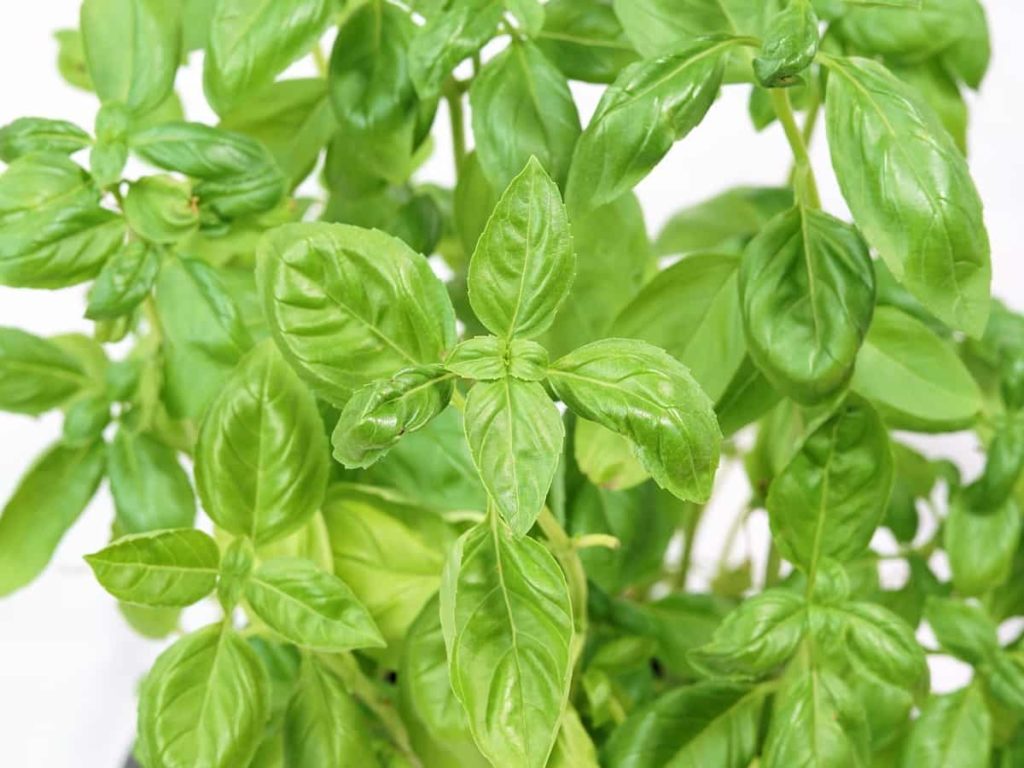Basil is a tender annual herb grown for its fragrant leaves. Sweet Basil is the most widely grown because of its delicious anise cloves flavor. However, many other types of Basil are available through the seed catalogs, including Lemon Basil, Greek Basil, Cinnamon Basil, and Thai Basil. Each offers a variety of flavors, shapes, leaf sizes, and even colors.

Basil is the easiest herb to grow indoors and outdoors from seeds. Since Basil is an annual, it grows very rapidly. Sprouting from seeds produces an abundance of fresh leaves, then flowering and going to seeds within a few months. Growing Basil from seeds is very easy, especially when you know all the secrets to success.
How to grow Basil from seed to harvest
How long does it take to grow Basil from seed?
- Basil is a straightforward crop to grow from seeds for summer harvests. Basil seeds germinate slowly, slightly faster when warmed from below, and Basil enjoys warm weather and full sun.
- The lifespan of the Basil plant is less than a year in any climate in which frost is experienced. Annual garden herbs like Basil die first with the frosts, roots, and all. It won’t return in the spring after the winter freezes.
- Under the right conditions, Basil seeds germinate very fast. On average, it takes around 5 to 10 days to germinate. But sometimes, they can be too slow. You can usually harvest Basil within 3 to 4 weeks. This is the ideal temperature for Basil to germinate between 19°C to 23°C.
What is the best way to grow Basil from seed?
- Choose a sunny place and amend the soil with a thin layer of compost. You should plant seeds in late spring or early summer, about a week or two after the last spring frost. The temperature of the soil should be at least 21°C. You should sow the seeds a quarter inch deep and one inch apart.
- You should sow 2 to 3 Basil seeds per cell or pot, plant them ¼ inch deep, and firm the soil well from the top. Keep trays or pots warm between 23°C to 35°C and moist until they germinate, which should be around 5 to 7 days under ideal conditions.
- Since Basil seeds need warmth to sprout, adding bottom heat is the best way to increase the germination speed. Soaking seeds before planting can also speed things up. Basil from seeds is easy to grow and doesn’t take much time.
In case you missed it: Common Basil Plant Problems: How to Fix Them, Solutions, and Treatment

Does Basil grow well from seed?
- It’s easy to grow Basil from Basil seeds. You don’t need special equipment.
- Most gardeners grow Basil by sowing seeds or transplanting seedlings into their garden beds or containers. However, a third option is much faster than waiting for the seeds to germinate. Growing Basil from cutting is a quick, easy and cheap way to maximize your crop of homegrown Basil.
- Start your Basil seeds in small pots or moist, peat-free multipurpose compost seed trays. Just sow more Basil seeds than you need, as most will germinate. Sow many seeds per pot and thin them with their growth until there are three to four strong stems.
Does Basil need full sun?
- Basil is a tropical herb; plants need sun and heat to thrive. Give it a place that receives the sun for six to eight hours a day, except in the south and southwest, where an afternoon shade is necessary. In addition, Basil requires moist, nutrient-rich soil that drains well. With proper sunlight, your plant will be large and beautiful for several months out of the year.
- Basil thrives in warm temperatures and the full morning sun. If your area has scorching midday sunshine, try giving your Basil a light shade at the hottest time of the day.
What month should I plant Basil?
- You can plant Basil two weeks after the last frost; the better once the soil is between 21°C. You can also plant it during the summer.
- This flavorful herb is perfect for garden beds, containers, and in-ground gardens. According to label recommendations, space Basil is usually at a distance of 12 to 18 inches. Grow in fertile, well-drained soil with a pH of 6.0 to 7.0.
- For outdoor growing, sow Basil seeds in late spring for transplanting in the garden after summer. Or sow directly in early summer once the soil is warmed up. Basil requires warm soil and full sun.
- Basil is a traditional annual summer herb. An excellent alternative to the desert climate, it tolerates heat well and prefers well-drained soil. If you’re going to plant Basil, late spring or early summer is the best time to do it.
Do you need to soak Basil seeds before planting?
- Soaking Basil seeds in warm water overnight will help speed up germination.
- Add 237 milliliters or 1 cup of water per 1 tablespoon of Basil seeds to soak the Basil seeds. Use more water if you want because the seeds only absorb as needed. Using too little water can cause seeds to clump as they hydrate. Soak the seeds for about 15 minutes.
- Sow 2 to 3 Basil seeds per cell or pot, and plant them ¼ inch deep. Keep trays or pots warm and moist until they germinate, which should be around 5 to 7 days under ideal conditions.
How often should I water Basil seeds?
- You should water Basil seedlings once every two days and in the morning. Seeds usually need to be watered at least once a day to keep the ground moist and not allowed to dry. Especially in warm climates, you may need water more than once daily.
- The top should feel cool and dry, while the bottom should be cool and moderately moist. It is difficult to determine in the ground, but the plant needs deep water at least once per week in full-sun conditions where the soil drains well.
- The first sign is that the Basil has been given overwatered, that the leaves begin to turn yellow or brown. In addition, the plant will start wilting, and if the Basil is getting too much water for an extended period, the roots will start to rot and smell like mold.
- Rotting roots are a common problem, and this happens because overwater is being given to the Basil. During the warmer months, it is recommended to water Basil every three days to avoid excessive drying out too much. However, if your pot is in a slightly shady place, you may water it appropriately every four days.
- But it’s better to keep checking using a soil test. If you have recently planted Basil, you should water the seedlings every two days or even daily if the temperature is too hot and you find that the soil dries up very quickly.
In case you missed it: Growing Hydroponic Basil, Hydroponic Basil Nutrients

Can you grow Basil indoors year round?
- Herbs like Parsley, Basil, and Thyme will flourish indoors with the proper care. Basil grows well outside in the ground, in a container, or on a raised bed. It thrives in moist, well-drained soil. Choose a location that receives 6 to 8 hours of full sunlight daily.
- Basil is the easiest herb to grow indoors. With appropriate conditions, Basil grown indoors can be equally successful as plants are grown outdoors.
- Plant it in the spring, and you’ll be able to harvest fresh leaves all summer. The key is to keep it in a sunny place and water. If you do, it should flourish and continue to produce fragrant foliage throughout the summer.
How many seeds do you put in one hole?
- Generally, two to three seeds should be planted per hole. However, seeds do not have a 100% germination rate, so not every seed planted will sprout.
- Do not exceed three seeds per hole. If more than one grows, cut the extra on the soil line as well. This prevents disturbance of the seedling’s roots, which you will keep growing while thinning.
- Once the seedlings produce the first set of true leaves, thin to 1 or 2 plants per pot. Basil transplants well, but plants would appreciate being protected from the wind and sun for the first several days. Grow Basil from seeds indoors, sow in rows in trays or two to three seeds per individual 1-inch pot. Once the seeds begin germinating, place them a few inches under the grow lights for fourteen hours a day.
Should I let Basil flower?
- It is better to remove the flowers if you are growing Basil for its leaves. Pinching Basil blooms back allows all the energy of the plant will be focused on the production of leaves, creating a bushy plant with more leaves and maintaining high levels of essential oils in the leaves.
- If you are growing Basil plants, you may already know it is a good idea to prune them as soon as they appear. Leaving flowers on slows leaf production, and many gardeners find that it also reduces the quality or taste of the leaves.
- Pinching these flowers helps keep the plant growing. But, while pinching flower buds will help, cutting half the plant and making pesto is even better.
Why are my Basil seedlings dying?
- The cause of the dying Basil plant is usually dry soil due to being underwater or the pot being too small, and the ground dries very quickly in the sun and high temperatures. Basil requires moist soil to prevent the plant from wilting, browning, and dying.
- Water your Basil plant well to help revive it. Keep it in bright, indirect light instead of full sunlight, and water your plant each time it feels dry to touch the soil’s surface. Once the plant benefits and new leaves are growing, you can place your plant back in direct sunlight and resume normal care.
Should I cut back Basil in winter?
- To prune for optimal growth, cut the central stem back by about a quarter inch from the set under the leaves. Basil plants initially grow a central stem. Once the stems are 6 to 8 inches long, pinch the main stem in half and about 1/4 inch above the leaf axils. As the plants keep sending new branch stems, keep pinching them back.
- Placed in a comfortable place under a sunny windowsill, it will continue to flourish during the cold months. Come summer, and you can replant it outdoors.
- You can try keeping Basil during winter. However, sweet Basil aims to live its life cycle within a year and then go to the seeds.
How do you pick Basil without killing the plant?
- Basil is a fast-growing herb that produces a lot of flavorful leaves. When you only need a few, the best way to harvest Basil leaves is to pinch each leaf at its base, where the leaves meet the stem. Start harvesting Basil leaves from the top of the plant, where more leaves will be filled quickly.
- When you prune the Basil stems back to a fresh set of leaves, you force the leaves to grow, doubling the Basil produced on that stem. And as those stems grow, you can pinch them back and double their yield.
- Cut about 1/4 inch above where the leaves are coming from the main stem. Do not take off more than one-third of the height, and cut from different parts of the plant to encourage branches all around. As your Basil continues to send new growth, continue to prune it.
In case you missed it: Growing Tulsi in Pots (Holy Basil), Planting, Care Guide

How big should Basil seedlings be before transplanting?
- To give Basil enough space to grow, it needs to be thinned two weeks after planting when the seedlings are about an inch long.
- You should wait until Basil seedlings are at least 3 inches long before transplanting.
- Once the seedlings have six sets of true leaves, pinch the top set of true leaves; this promotes the growth of vigorous, bushy plants. As your Basil plants grow, you can quickly put them in large containers, be sure to bury the stems to form strong plants.
Are coffee grounds good for Basil plants?
Coffee ground fertilizer is safe for Basil and other herbs. Herbs benefit from promoting nitrogen that provides coffee grounds. Finely sprinkle the used coffee grounds on the soil of your Basil plant, and then work it into the soil. It is an inexpensive and environmentally friendly way to promote soil nutrients. Remember that since coffee grounds are slow-releasing fertilizers, they will not immediately release nitrogen into the soil.
Why is my Basil so leggy?
- Basil plants grow leggy due to excessive use of fertilizer, not enough sunlight, and lack of regular pruning. Basil requires full sun, fertile soil, and pruning once every two weeks to maintain a bushy shape with abundant leaves but then leggy Basil with fewer leaves.
- If the Basil plant is growing vertically, pinch the leaves from above to encourage lateral growth. Basil grows fast, even if you don’t want to use the leaves immediately, keep trimming the plant when it becomes larger and bushy.
- It requires a balanced environment and moist, well-drained organic soil. Furthermore, the Basil plant thrives in full sunlight and prefers frequent watering. Cutting a few leaves every two weeks to maintain a bushy shape and discourage the growth of leggy stems on the Basil plant.
What kind of soil does Basil like?
- These plants thrive in soil rich with a lot of organic matter, such as compost, and need a pH of 6.0 to 7.0. If you’re unsure about your garden’s pH, use a soil tester to measure it.
- Basil prefers moist soil, not too wet and not too dry. Although Basil loves warm weather, a warm afternoon sun can be harsh. If you see wilting only during peak hours for summer temperatures, you may need to add a light shade to your Basil plant.
- Basil prefers rich, moist, well-drained soils with a pH of 6 to 7. Test your soil, or improve it by adding lots of organic nutrients from compost, blood, or cottonseed meals.
How deep should I plant Basil seeds?
- Dig or till at least 6 to 8 inches or work in generous amounts of compost or well-decomposed manure before planting, along with a balanced, all-purpose fertilizer.
- Plant seeds ¼ inch deeper, 2 or 3 seeds per inch, 18 inches in rows. It is unnecessary to be thin, but a final spacing other than 4 to 8 inches produces healthy, complete plants. Whatever type of container you use for Basil seeds, sow each seed at a distance of about an inch.
Can Basil grow close together?
- You can plant Basil plants close together. However, the plants will struggle to thrive and remain small with few leaves if they are too close.
- You don’t want to crowd your plants, although if you’re making your pot for looks and function, you can keep the plants close by 12 to 18 inches. Try them more like a distance of 6 to 8 inches. However, Basil is prone to fungus, so it is essential to maintain airflow between plants.
- The bed or garden container should be 8 inches deep for strong root growth. Place your Basil plants at a distance of 12 to 16 inches to allow enough sunlight and airflow.
In case you missed it: Growing Basil from Cuttings, Seeds – A Full Guide

What fertilizer does Basil like?
- Apply it when you usually water the plant. If you choose a granulated type of fertilizer, choose a balanced fertilizer with equal amounts of nitrogen, potassium, and phosphate. The 10-10-10 or 12-12-12 formulas work well to fertilize Basil. Scatter the grains around the plant and water them thoroughly.
- You can reuse coffee grounds, stale beer, tea (green or black tea), or mineral water as a simple homemade fertilizer. Using fertilizers like Coffee Ground for your Basil also helps reuse food waste and saves money.
- Feed your Basil plants with a good organic fertilizer every four to six weeks for indoor plants and every 2 to 3 weeks for outdoor plants.
Are eggshells good for Basil plants?
- Basil requires certain nutrients, and eggshells provide calcium. All plants need nitrogen, phosphorus, and potassium; however, they also need other trace minerals, including calcium. So, whether you grow Basil in an eggshell or add it as a soil amendment, it will help your Basil and other plants.
- Do not use eggshells directly on Basil plants. Instead, you should dry, break and mix them. Spread powdered eggshells around the base of the Basil plant. Also, cover the powder with a layer of garden soil. Water generously. The second option is to add eggshells to the compost bin.
How many times can you harvest Basil?
You can cut Basil as often as possible during the growing season, as long as you have Basil left. Harvesting Basil leaves above each stem will ensure they can regrow after harvesting. You can remove the Basil plant up to half the height, but leave at least one pair of leaves at the base of the stem.
In case you missed it: How to Grow Tomatoes from Seeds: Starting from Scratch, A Beginners Guide to Indoors, Outdoors, and in Pots

Conclusion
Basil plants don’t live indoors or outdoors for long as they are annual, so don’t worry if your plant dies within months. Fortunately, Basil grows easily with seeds, so you can keep growing the Basil crop throughout the year in your herb garden. Growing Basil means the freedom to experiment with a host of Basil types. Sweet Basil may be a traditional type of planting, but purple and citrusy lemon Basil also comes in handy. Thai Basil brings hits of sharp anise to South Asian soups, aromatic curries, and stir-fries.
- Flower Garden Designs and Layouts for Beginners
- Planting and Spacing Techniques in Papaya: A Beginner’s Guide
- Growing Gold: Essential Techniques for Planting Pineapples
- How to Make Kalanchoe Plant Bushy: Home Remedies and Solutions
- 11 Reasons Why Your Gardenia is Not Blooming: Home Remedies and Solutions
- Eco Elegance: The Guide to Designing a Drought-Tolerant Landscape
- Gardening on a Slope: Strategies for Hillside Landscaping
- Nourish and Flourish: Top Organic Mulches for Thriving House Plants
- Everything You Want to Know about Indian Mogra Flower: Discover Uses and Growing
- Green Thumb Success: Expert Tips for Cultivating Greenhouse Pumpkins All Year Round
- Maximize Growth & Flavor: The Ultimate Guide to Companion Planting in Herb Gardens
- How to Control Rhododendron Problems Naturally: Home Remedies and Organic Ways to Fix Them
- Natural Magic: The Remarkable Benefits of Cinnamon for Plants
- Best Steps to Revive Dying Tulip with Natural and Organic Treatment
- 10 Reasons Why Your Angel Trumpet is Not Blooming: Remedies and Treatment
- How to Fix Periwinkle Leaf and Flower-Related Problems: Natural Remedies and Solutions
- How to Fix Zinnias Leaf and Flower Problems: Discover Natural and Home Remedies
- Organic Steps to Induce Lemon Tree Flowers: A Comprehensive Guide
- Bloom Booster: Crafting the Perfect Homemade Bougainvillea Fertilizer
- Optimizing Growth: A Guide to Applying NPK Fertilizer for Potted Plants
- 10 Best Homemade Fertilizers for Rubber Plant: DIY Recipes and Application Method
- How to Boost Female Pumpkin Flowers: Effective Steps for More Flowers and High Yields
- Transform Your Indoor Garden: Top Benefits of Pink Salt for Houseplants
- 10 Best Homemade Fertilizers for Peacock Plants (Calathea): Easy DIY Guide
- Unlock Blooms: 9 Reasons Why Your Potted Chrysanthemum is Not Blooming
- 8 Reasons Why Your Potted Hibiscus is Not Blooming: Fix it with Simple Solutions
- Unlock Blooms: 9 Key Reasons Your Potted Frangipani Won’t Flower
- 10 Reasons Why Is My Ice Plant Not Blooming: Remedies and Treatment
- 10 Reasons Why My Potted Hydrangea Not Blooming: Treatment and Remedies
- 10 Reasons Why is My Wisteria Not Blooming: Remedies and Treatment
- 10 Reasons Why is My Goldfish Plant Not Blooming: Remedies and Treatment
- Maximize Your Space: Ultimate Guide to Balcony Gardening with Grow Bags
- 10 Reasons Why Your Iris is Not Blooming: Remedies and Treatment
- 10 Reasons Why Your Anthurium Plant is Not Blooming: Treatment and Remedies
- 10 Reasons Why Your Aquaponic Plants Are Not Flowering: Remedies and Treatment
- 10 Reasons Why Your Agapanthus is Not Flowering: Remedies and Treatment